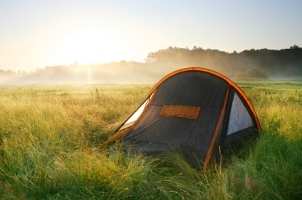Tent Buying Guide
by Craig Blake
When you get out of the house and live under a tent, even for a night or two, you are joining a tradition as old as humanity. Nowadays, camping tents are used for recreation more than as a necessity. Still, there is a timeless appeal about camping in a tent. Modern tents come in a wide variety of sizes and styles. Knowing a few basics will help you purchase exactly the tent you need for your next expedition. We're more than happy to help you find it.
What you need to know:

Shop Tents ▸
- Tent buying tips:
Every camping trip is different, and no tent is perfect for every situation. Think about the number of campouts you typically take each year and where you generally go. If you plan on backpacking, you'll want a lightweight backpacking tent. If you are driving up to the camp site, you don't need to worry so much about the tent's weight. It can never hurt to have a few tents for whatever camping trips you plan to go on.
- Tent styles:
Dome tents are probably the most popular style, partially because they can be set up and taken down easily, even by one person. Backpacking tents are lightweight and compact, making them great for long-distance hikers. They are also durable enough to do the job under a wide range of weather conditions. Family tents are big and often made of heavy, treated canvas. You can fit the whole group into the spacious interior of this type of large camping tent, but if someone has to pack it in and out, they will need help with the rest of their gear. The large size means added cost, and these aren't always that easy to set up and take down. Alpine, also called expedition, tents are the top of the line, designed to withstand extreme conditions. Expedition tents can be high priced, so they are really suitable only for the most adventurous campers.
- Tent components:
Aside from general tent components such as stakes and poles, some tent features are added to help keep you dry. A vestibule is an extension that covers a small area in front of the tent opening -- a place to remove shoes or drop backpacks before going in. It also helps keep rain or snow away from the tent entrance and out of the tent itself. A "rain fly" is an additional layer of fabric that covers the tent, adding wind and water protection. If the fly doesn't reach the ground, splashed water can get under it. Make sure you attach the fly even if it doesn't look like it will rain. If it does, you might not have time to put it on before your tent gets wet.
- Tent care:
First, before using your tent, seal it. The manufacturer says they already did, but you can never be too careful when it comes to staying dry. Practice setting up the tent; mistakes at the campsite can damage the tent, poles and stakes. Also, never pack your tent wet. It will get wet sometimes, so when you get home, set up your tent and let it dry out after each trip. If you find mildew, wash it gently with warm water. Finally, keep a roll of duct tape close by; it's great for field repairs, like patching the fly or tent wall or holding a broken zipper closed. It's just a quick fix, but it will get you through the weekend.
Be fully equipped: Take a good look at the camping equipment you'll need for the trip. Even inside a tent, sleeping bags are a must. If you think you might get lost, navigation aids can derail those plans very effectively. If needed, don't forget your hunting and fishing gear. Speaking of dinner, a good set of camp cookware can really make that camping tent feel like home.
Go camping: On the home page of the U.S. National Park Service, you'll find a map of the United States. Click on your state, or any other, and a list of parks in that state will open up. The NPS maintains these parks and camp sites just for campers like you. Take advantage of them.



















